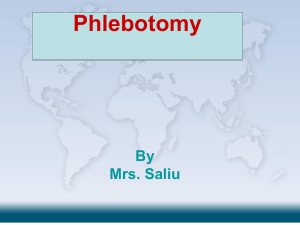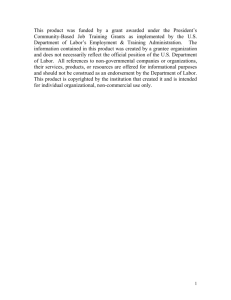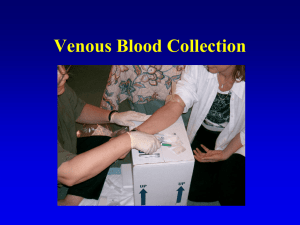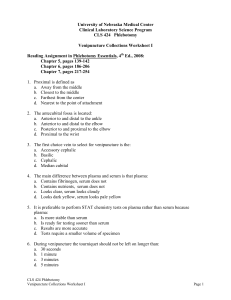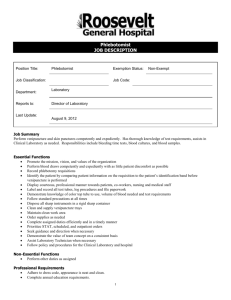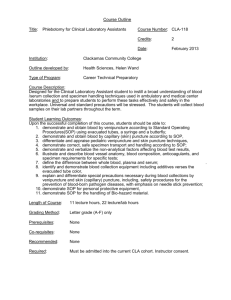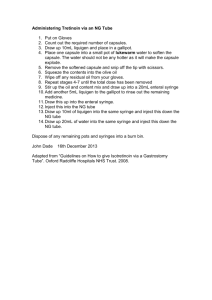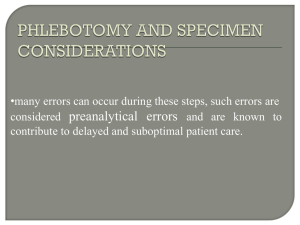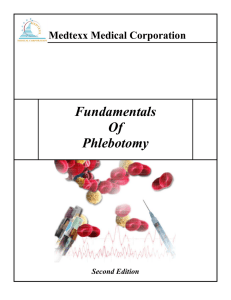Angeles University Foundation Angeles City College of Allied
advertisement
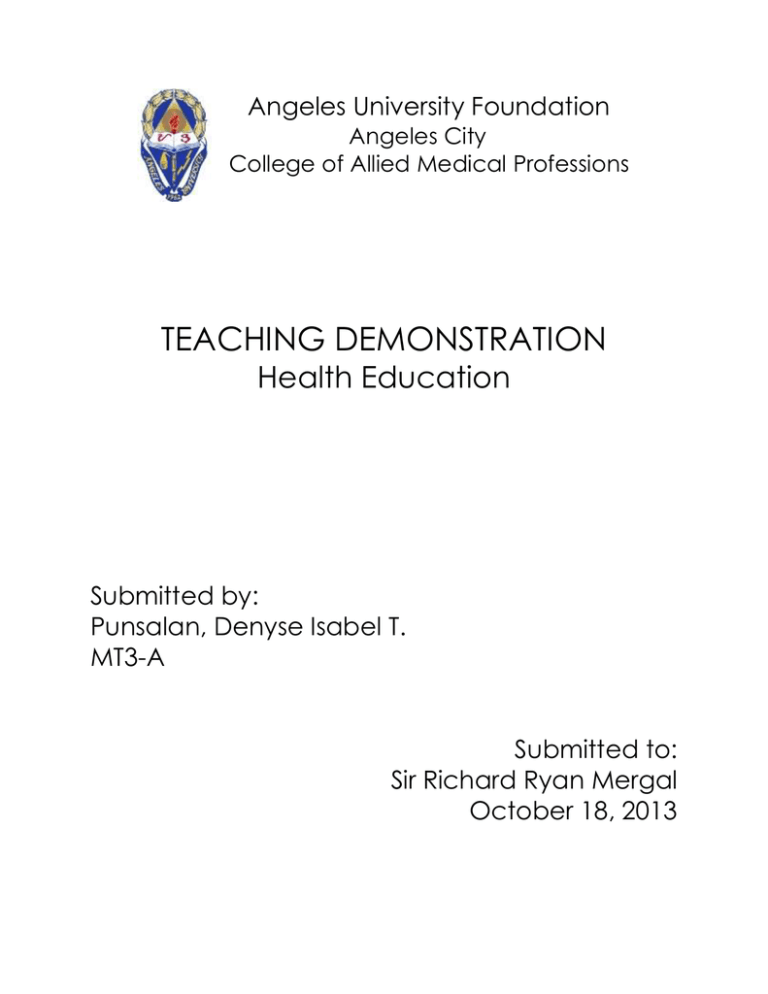
Angeles University Foundation Angeles City College of Allied Medical Professions TEACHING DEMONSTRATION Health Education Submitted by: Punsalan, Denyse Isabel T. MT3-A Submitted to: Sir Richard Ryan Mergal October 18, 2013 Mini lesson plan: Subject: Clinical Chemistry Topic: Venipuncture Time allotment: 6 hours Objectives: Cognitive Psychomotor Affective To define terms related to venipuncture To identify sites used for venipuncture To differentiate the additives in the vacutaner tubes from one another To discuss the steps in venipuncture To discuss the parts of an evacuated tube system To assemble the evacuated tube system To demonstrate how specimens are dispensed in the container To act respectfully when it comes to performing the procedure To respond to the needs of the patient To accept standards regarding certain procedures in the laboratory Teaching method: Discussion – teaching method for the cognitive and affective objectives Demonstration – teaching method for the psychomotor objectives Procedural steps: Goodmorning! Today I’m going to discuss about venipuncture but first, let me discuss to you the terms that are related to venipuncture. First would be phlebotomy, when we talk of phlebotomy, it is the process of collecting blood but when we talk of venipuncture, it is a process wherein blood is collected through a needle inserted into a vein. So the difference between phlebotomy and venipuncture is that venipuncture is concentrated into a vein but when we talk of phlebotomy, it could either be through a vein, through capillary puncture or any method that is related to collecting blood. The next thing I’m going to discuss would be the ideal sites of puncture. There are three sites which can be punctured, first would be the median then the cephalic and lastly, the basilic vein. The median cubital is located at the center of the antecubital fossa, it is located in the middle. It is the ideal site of puncture because it is least painful when extracted and doesn’t roll which means it is well anchored. The next one would be the cephalic vein, it is located outside, it is fairly well anchored and this would be the most prominent vein in obese patients. Last one would be the basilic vein. It is located inside, it is not well anchored and it easily rolls. Order of draw and most common additives: Stopper color Additive Yellow SPS (Sodium Polyanethol sulfonate) ACD (Acid Citrate Dextrose) Light blue Sodium Citrate Red None Green Lithium/Sodium Heparin Lavender EDTA (Ethylene diamine tetraacetic acid) Gray Oxalate Department Microbiology Bloodbanking/Immunohematology Coagulation Chemistry, BB, Serology/Immunology Chemistry Hematology/Blood banking Chemistry Evacuated tube system: These are the parts of the evacuated system, first would be the multisample needle which allows multiple collection of blood. The tube end is covered with a sleeve and it retracts when it penetrates the stopper. It also recovers the needle after the procedure so that leakage won’t be seen after the procedure. The next part would be the tube holder, it is a plastic cylinder with a safety device. Some tube holders don’t have a safety device so if that’s the case, your needle should have the safety device. The last part would be the evacuated tube, it is more ideal if your patient have many test requests. It has a pre-measured volume and it sucks the blood according to the volume indicated in the tube. Whenever doing the procedure, we should always show respect to the patient. We should also keep in mind that there are certain conditions that may arise during the procedure so we should also think about their safety. Some of these conditions or problems are allergies, excessive bleeding, fainting, nausea, obese patients, pain, petechiae and seizures or convulsions. We should keep in mind that we should think of the safety of the patients. We should also keep in mind that sometimes laboratories have different standards compared to others. Some laboratories have this kind of standards that doesn’t apply with another laboratory so we should keep in mind that whenever doing procedures, we should have the knowledge and skills that we need but when it comes to other things like processing time or the operating time of the machines, they may not the same with what we have used to do so we should be knowledgeable with those kinds of things. We should also respect and follow them. Some of the precautionary measures that should be observed are the following: Know the test being requested by the patient so you would be able to prepare your materials Prepare materials ahead of time Ask his/her name and it shouldn’t be a confirmatory question that can be answered by yes or no Always sanitize your hands before and after the procedure Ask if the patient had any history of allergies to latex or disinfectants After doing the precautionary measures, start the procedure by sanitizing your hands. Apply the tourniquet and make your patient close his/his fist, palpate and choose your best site of puncture. Do not use your thumb because it has a pulse. Remove the tourniquet, sterilize the site. Arrange the syringe, make sure it is well anchored and it has no air inside. Place the tourniquet, place your gloves and palpate your chosen site again and do not touch the surface you’ve sterilized. Then do the puncture procedure and when blood is already seen in the tip of the syringe, gently pull the plunger and keep your eyes on the needle. After, remove the tourniquet open his/her fist and remove the syringe from the puncture site. Place the dry cotton and apply pressure. After obtaining blood sample, this would be how the specimens would be dispensed. First, remove the needle from the barrel of the syringe and place the needle in the sharps container. Open the vacutainer tube and carefully dispense the blood. Dispense it at the sides of the tubes and not directly because if that’s your way of dispensing, your blood sample might hemolyze. Label the tube with the proper information needed. Do the processing of the specimen. That’s all, thank you! Method of evaluation: Post test I. Match the color of the stopper tube with their additives. Write the letter of your answer before the number. II. 1. Light blue A. SPS or ACD 2. Gray B. No additive 3. Yellow C. Lithium/Sodium Heparin 4. Red D. Oxalate 5. Green E. Sodium Citrate Modified true or false. Write true if the statement is true and if false, change the highlighted word with the appropriate term to correct the sentence. 1. The ideal site of puncture for obese patients would be the basilic vein. 2. Phlebotomy is any procedure related to collecting blood. 3. The multisample needle is a plastic cylinder with a safety device. 4. The median cubital vein is located at the center of the brachial fossa. 5. The syringe system is preferred if the patient have many test requests. 6. In the usual order of draw, the red top would be followed by the yellow tube. 7. You can discard the needle together with the barrel of the syringe. III. Transcribe 1. SPS 2. ACD 3. EDTA IV. Enumerate the correct arrangement of the tubes in multisample collection. Write only the color of the stopper. (6 points) 1. 2. V. 3. 4. 5. 6. Enumerate some precautionary measures to be observed while performing the venipuncture procedure (before, during or after the procedure) 1. 2. 3. 4. ANSWER KEY I. II. Match the color of the stopper tube with their additives. Write the letter of your answer before the number. E 1. Light blue A. SPS or ACD D 2. Gray B. No additive A 3. Yellow C. Lithium/Sodium Heparin B 4. Red D. Oxalate C 5. Green E. Sodium Citrate Modified true or false. Write true if the statement is true and if false, change the highlighted word with the appropriate term to correct the sentence. Cephalic True 1. The ideal site of puncture for obese patients would be the basilic vein. 2. Phlebotomy is any procedure related to collecting blood. Tube holder 3. The multisample needle is a plastic cylinder with a safety device. Antecubital 4. The median cubital vein is located at the center of the brachial fossa. Evacuated tube 5. The syringe system is preferred if the patient have many test requests. Green 6. In the usual order of draw, the red top would be followed by the yellow tube. Cannot 7. You can discard the needle together with the barrel of the syringe. III. Transcribe 4. SPS- Sodium Polyanethol sulfonate 5. ACD- Acid Citrate Dextrose 6. EDTA- Ethylene diamine tetraacetic acid IV. Enumerate the correct arrangement of the tubes in multisample collection. Write only the color of the stopper. (6 points) 1. Yellow V. 2. Light Blue 3. Red 4. Green 5. Lavender 6. Gray Enumerate some precautionary measures to be observed while performing the venipuncture procedure (before, during or after the procedure) Know the test being requested by the patient so you would be able to prepare your materials Prepare materials ahead of time Ask his/her name and it shouldn’t be a confirmatory question that can be answered by yes or no Always sanitize your hands before and after the procedure Ask if the patient had any history of allergies to latex or disinfectants
